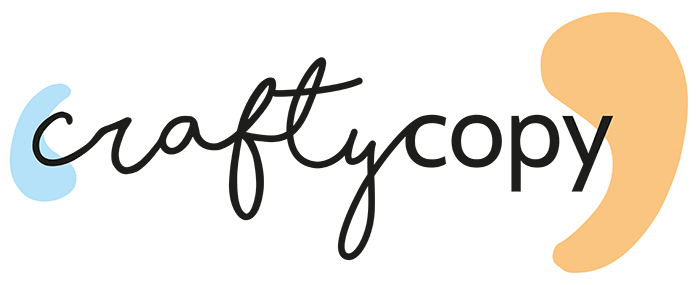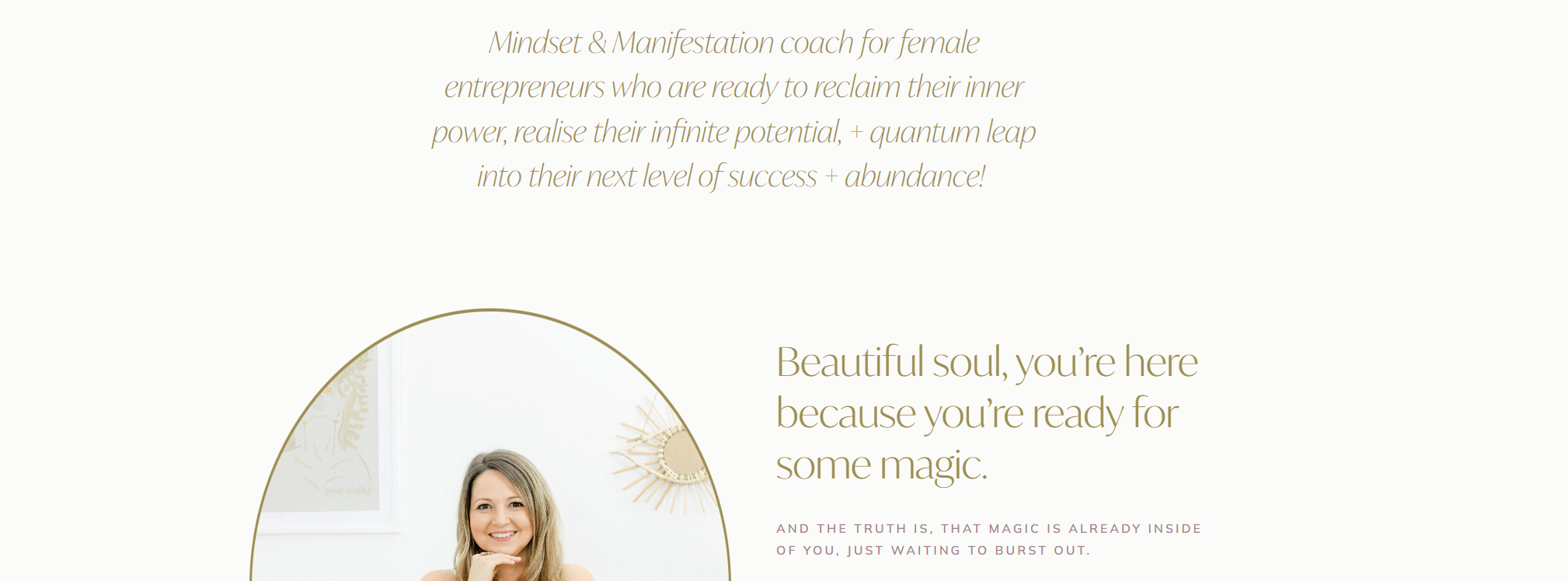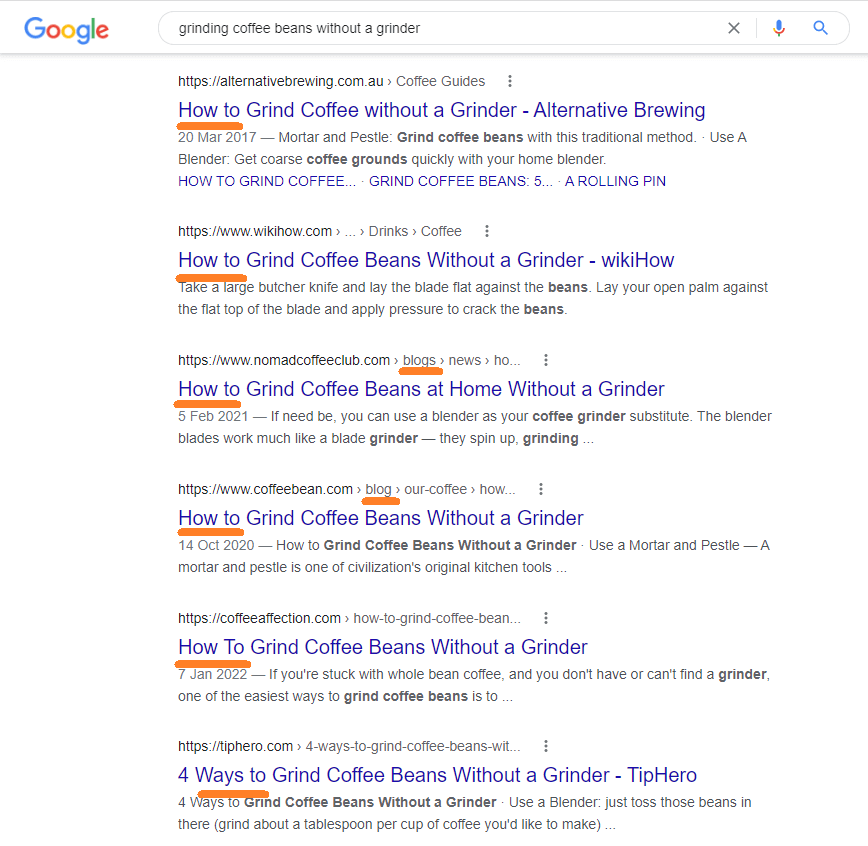How to Write Website Copy That SELLS: Guide for Founders
Talking about your business is NOT enough! Here’s a step-by-step guide on how to write website copy that attracts your dream clients and brings you leads.
Anyone can write website copy. But not everyone can craft strategic and effective copy that does more than just “be there.”
In fact, most business owners end up filling their website with words that don’t bring any results.
So, as a professional website copywriter, I’ll teach you how to write website copy that sells (step-by-step).
But first, let me show you what you’ve actually been missing out on so far.
What should your website copy do for you?
Your website copy should be your best salesperson: working in the background for you 24/7—no breaks or holidays allowed.
More specifically, it should:
Position you as THE go-to solution in your dream client’s eyes
Attract your audience organically on Google
Repel the wrong-fit customers (unless you’re happy to spend hours running random discovery calls or waste money on refunds?)
Connect with your target prospects
Actively sell your services rather than just describing your business
Bring you new leads regularly
Has your current website copy not being doing all this? Or perhaps your website is new so you’re writing it for the first time and want to start with a bang?
Then, here’s how to write website copy that does aaaaaaaaaaaaall that for you.
Step-by-step guide on how to write website copy for your business
Disclaimer: this isn’t something you’ll get to do in one go as you read this blog post.
So, bookmark it right now and come back to it as you work your way through these steps.
Done? Let’s start.
1. Get clear on your brand messaging before writing your website copy
Brand messaging is how you talk and write about your business, what you focus on the most, and how you convey your value proposition to your dream audience.
This must be consistent across all your marketing channels.
And specifically, as soon as they land on your website, your audience should understand:
Exactly what you do
Whether it’s for them
How this will benefit them / why they should care
But they won’t be able to do that if YOU are not clear on that first.
So, start here, and keep brainstorming until you get to a clear overview.
2. Research, research, research
I know you’re here to learn how to write web copy, but take it from a professional copywriter: writing is actually the smallest part of copywriting (ironic, considering it makes up over 60% of the actual word!).
The biggest? Research, planning, and strategy.
Now, you might be thinking “Well, it’s different for you, because you write for different clients every time: I already know my business!”
But trust me: starting to write your website copy without getting clear on the following points is a risky game—even if it’s your business. Why?
Because you’d end up relying on assumptions or what you’re remembering, which isn’t the whole picture.
So, instead:
Get clear on your target audience – Who exactly are they? Be as specific as possible: when you try to target eVeRyOnE, you end up connecting with no one
What are their pain points? – If they’re looking for your types of services, it’s because they’re trying to solve a problem (or two)
How does your business fix them or help them overcome them? – This should create a strong contrast against their current situation
What are your audience’s most common objections? – Even if they’re looking for your types of services, your audience is still coming up with reasons not to part with their own money (more or less subconsciously). For example, these might be “I could just do it myself” or “Maybe I can worry about this in a few months”
What are the most impressive results you’ve achieved? – Anyone can say “I’m good at what I do” or keep it vague like “I’ll take your business to the next level”, but what can that look like in practice?
Reread your testimonials and feedback – What do your clients value the most? What words do they use? This is also part of your voice of customer research: you’ll want to use terms your audience is already familiar with, not buzzwords and complicated jargon
Remember your calls, and go through your email exchanges – This will help you identify more pain points, objections, and common patterns
Analyse your competitors – Look at their website copy (for example, did they bring up some points you hadn’t thought of?), testimonials, and reviews (are there any negative ones you can keep in mind to set your business apart?)
Lurk where your audience is active – From your own social media posts to shared communities and forums like Reddit: what does your audience have to say when it comes to your industry and types of services? Once again, this step is also useful for voice of customer research
3. Find the right keywords to include in your website copy
Learning how to write website copy that sells is a game-changer for your business. But if you don’t optimise it for SEO, who’s going to read it?
Sure, you can direct your existing audience to your website. But why exactly would you want to miss out on those who’re actively looking for your types of services on Google?
If you forget about them, they’ll find your competitors instead. Harsh but true.
Now, don’t get me wrong: nobody can guarantee that you’ll show up on Google’s first page. There are too many factors that influence those rankings, and you haven’t got any control over some of them.
But when you optimise your website copy for the keywords that your audience is searching, you’re giving yourself the very best chances—and why leave them to your competitors?
So:
Use one of the best free or affordable keyword research tools (as a beginner, you can start with Google Keyword Planner)
Look for your type of business, services, or products to find the best keywords to describe them: what are people actually searching for? (Psst: it might not be your first guess)
For example, some of my clients found me because they were looking for a “website copywriter”, a “copywriter for female entrepreneurs”, or “website copywriting services.”
BONUS TIP: you can’t just upload your new copy, never touch your website again, and hope it magically gains traction on Google! You must blog on it regularly, too. This will also allow you to target the biggest chunk of your audience: those who’re trying to find out more about their pain points and/or your industry but aren’t ready to invest just yet. A win-win!
4. Plan your website copy structure—and keep it simple
Maybe you’re building your website from scratch. Perhaps you already have one and are looking to replace its copy. Either way, make it or keep it as simple as possible.
Identify your main goals – What do you want your website copy to promote the most? For example, this could be selling your premium offer and getting more newsletter subscribers
Plan the right website pages and an intuitive menu – You don’t want to overwhelm your audience with endless menu items! Otherwise, they won’t know what they should actually click next
Now, the latter really depends on your type of business, of course. However, a popular menu structure is:
Home page
About
Services (overview)
- Pages for each individual serviceContact
But you might benefit from additional pages like a portfolio, success stories, sustainability, etc.
5. Write your website copy for your audience, NOT yourself
You’re here to learn how to write website copy that actually sells, right? Then, remember you’re not the one buying your offers: your audience is.
So, you shouldn’t write your website copy in a way that strokes your ego, impresses your family, or matches your personal taste.
You must write it in a way that connects with your audience and gets them to take action. That’s all that matters!
So, here are some mindset shifts and points to consider (and never lose sight of):
Always write your website copy with your audience in mind – What do they need to know? Hint: NOT that “I’m passionate about what I do”
Address them directly – In fact, try and use “you” more often than you say “I/we”
Your audience is the hero of the story – Don’t make the mistake of positioning yourself as the hero! You’re the trusted guide who’ll help them achieve their happy ending (which is still pretty cool, isn’t it?)
Focus on the benefits of your services, not their features – For example, Apple didn’t try to sell the first iPod by saying “5GB of storage”. They said “1,000 songs in your pocket” (I know that’s not as impressive today, but come on: this was all the way back in 2001!)
Use the “so what?” test – When you write your website copy, put yourself in your dream client’s shoes and, after every paragraph, ask yourself: “So what? Why should I care?” If you can’t answer it, that section needs to be reworded or removed altogether
Use your audience’s language – Refer to your voice of customer research when writing website copy for your business
Spin your brand story – Storytelling in marketing leads to +30% conversions when used correctly! And that’s why your brand story must position your audience as the hero and show them the transformation you’ll bring about for them
6. Write a website copy draft for each page
What you actually include and focus on will really depend on your unique business and goals. However, here’s a website copywriting plan that tends to work for most.
How to write website copy for your Home page
Use it to provide a clear overview of your business and to then direct your visitors to the right page or next step for them.
Some key sections:
Above the fold (everything they see before scrolling down): this should clarify exactly what you do, who for, and how it benefits them, as well as offering your main calls to action
Connecting with your audience’s pain points and presenting your business as the obvious solution
Clear breakdown of your services with links to the relevant pages
Testimonial section / social proof
Short about section linking to the About page
Newsletter or lead magnet section
How to write website copy for your About page
This page should show your audience why they can trust you with their money—and why they should choose you.
So, you can cover:
How your own experience and mission is relevant to your audience
Why you’re the best possible person for it (e.g. experience, background, certifications, etc.)
And don’t treat it as a dead page: add a call to action at the end (for example, to head to your Services page)
How to write website copy for your Services/How to work with me page
Build it as an overview of all your services to help your audience identify the right one for them at this stage:
Have smaller sections for each of them
Include direct calls to action
How to write website copy for your individual Service pages
The aim here is to sell that service (duh):
Offer a clear overview of that offer in a couple of sentences (much like your above-the-fold section on your home page, but focusing on this service alone: what it is, who it’s for, how it benefits them)
Connect with your audience’s pain points
Reference what they’ve already tried to do to solve them (and why it didn’t work)
Tell them what’s really causing that problem, and present your approach as the obvious solution
Introduce your service again
Paint a vivid picture of the final outcome
Tackle their most common objections and help them understand whether or not it’s for them
Clarify everything that's included (but try and focus on the benefits rather than features alone)
Include plenty of social proof, like previous results or client testimonials
Remind them of why they should trust you
Include FAQs, if relevant
Wrap it all up, and end it with a strong call to action (but scatter a few more throughout the page)
How to write website copy for your Contact page
Don’t just have a sad contact form without any kind of context!
Remind your audience of why it’s important that they take action or give them a final nudge
Clarify what happens next (for example, if they have to submit a form, you could mention that you’ll get back to them within 2 working days)
BONUS TIP: add social proof throughout your core pages too, starting from your Home
7. Optimise your new website copy for SEO
Remember those keywords I told you to look for?
Whenever possible, every page should target a main one, but you can also use similar keywords to complement it and help your audience find you.
Try and use your keywords in:
Titles and headings
The first 100 words of your copy on that page
A few times within the text
Anchor text (the clickable words of a link)
Image alt text
Your meta description
but only when it feels natural. Don’t force them! Nobody likes to read a robotic text.
You also need to use your headings hierarchically—which, in this case, is just a fancy way of saying “in the right order”.
Don’t skip this step, because wrong headings are one of the mistakes I encounter the most when I review website copy written by someone who isn’t a professional SEO copywriter!
Have only one heading 1 per page (your title)
Then, introduce the next core section with a heading 2 (e.g. “Has your graphic design been holding you back?”)
If the following section is still very much related to that one, use a heading 3 (for example, “How your current graphic design is sabotaging your business”)
If it covers a completely different point, then it should be a heading 2, meaning that it has same value as the previous one (e.g. “Here’s how we’ll change that”)
And so on
Whatever you do, don’t ever use your headings to format your text and make a random sentence pop. Not to be dramatic, but that would DESTROY your SEO.
8. Edit your website copy, and make it easy to read
As they say, “kill your darlings.” Just because YOU like a specific word or sentence, it doesn’t mean you should keep it.
So, while learning how to write website copy is key, I’d say that editing your first draft is just as important.
How to edit your website copy:
Get straight to the point, and remove all the fluff (like “Welcome on my website”)
Remember that the goal of each line is to get your audience to read the next
Still, most people will skim it (that’s where my readability tips will come into play soon)
Clear > clever – Don’t say something vague like “I offer business solutions” just because it sounds fancy. What does that actually mean? Is it a consultancy service? Software? Be specific!
Once again, remember the “so what?” test
Read your website copy out loud (I promise it makes a huge difference!)
How to enhance its readability:
On each page, divide your website copy into sections with headings
Use shorter paragraphs: nobody wants to read a huge block of text
Use bullet points
Use bold (sparingly) to highlight your key concepts and make things even easier for anyone who’s skimming your website copy
9. Use your website copy to inform your design (NOT the other way around)
If you’re updating your existing web copy, don’t try and force your new text into your old sections.
And if you’re learning how to write website copy for a new website, plan its design around your structure and words.
This will allow you to highlight the most important sections and make the entire copy easy to read.
That’s why I always wireframe it before delivering it to my clients—to help them get the very best out of it.
Because here’s the truth: you can learn how to write copy for your website or hire the best copywriter… but if you then upload it as one block of text? Or mess up its design?
Your audience will struggle to read it—and they might easily give up.
So, make your website copy and design work together strategically.
10. Proofread your website copy again, even after you’ve uploaded it
I swear some typos only show up after you’ve hit “publish”!
So, read your website copy again and look for:
Typos
Repetitions (that’s why reading it out loud is key)
Consistency in spelling and styling (e.g. whether or not you’re using the Oxford comma, ampersands or “and”, etc.)
You can also use proofreading tools like Grammarly.
11. Refer to your website copy through the rest of your marketing and content
Another common mistake I encounter when working with new clients?
Their website copy tells one story, their LinkedIn profile a different one, their Instagram is a separate thing altogether, and so on.
Nope, nope, NOPE.
Your brand messaging and story should be consistent no matter where your audience is reading about your business.
Otherwise:
They’ll get confused
They’ll struggle to understand what your business is actually about
They won’t remember it
They won’t automatically think of you when they’re ready to invest
So, don’t ever lose sight of the brand messaging and story that you crafted when writing your website copy. In fact, you can (and should) even use the same wording in some cases.
For example, the top section of your home page and your social media bios should be extremely similar.
Some website copy examples to help you write yours
It’s easier to learn how to write website copy when you see it in action.
So, here are some examples of the strategic copy that I’ve written for some clients after clarifying their brand messaging.
Key elements:
what type of business this is (“boutique web design agency, digital consultancy, and learning platform”)
who for (“female high-flyers”—like them)
how it benefits them (“take off by starting your own business”, “propel it forward and higher up” and, overall,“fly their business to their dream destination”) and what they can expect, specifically (“website, tools, and resources”)
what they should do next (“find the right flight for you” or, if they’re not ready to invest, subscribe to their newsletter to “learn from our free tips & in-flight magazines”)
And another snippet:
See? Written with an actual strategy, focused on their audience, and crystal clear.
How I can help you 1:1 and write website copy for your business
I hope my guide on how to write your website copy was useful!
But yeah, I can’t deny that it’s A LOT of work.
So, if you’d rather leave it to a professional instead of wasting weeks on trial and error, check out the 🧲Magnetic Message & Web Copy Makeover✨
With my brand messaging and website copywriting offer, you’ll get:
🧲A clear and fine-tuned brand message positioning you as THE go-to solution in your dream client’s eyes
🧲A strategic brand story woven around your target audience and following a proven framework
🧲Powerful website copy that cuts through the noise, connects, and converts… even when you’re sleeping or enjoying some well-deserved time off
🧲All the right SEO keywords to help your audience find you organically on Google when they’re looking for your type of business
🧲Bespoke brand messaging & storytelling guide so that you can always keep them consistent and amplify them through your content
Ready to go from “just another option in your niche” to “THE go-to solution for your ideal clients” in 3 weeks and start relying on website copy that actually sells for you 24/7?
More #crafty blog posts on this topic:
How to Use the 5 Pillars of Magnetic Marketing to Attract Clients
Spending too much time reaching out to people? Mainly attracting the wrong-fit prospects? Let's fix it by implementing the 🧲5 Pillars of Magnetic Marketing🧲
What if, instead of struggling to get leads and wow them with what you do, you could attract them organically? And by the time they get in touch with you, they’re already sold?
That’s the power of magnetic marketing—and specifically, my 5 pillars.
I’ll show you exactly what you need to focus on to implement them in your business.
Bu let’s start with a quick definition to make sure we’re on the same page.
What is magnetic marketing?
Magnetic marketing is a promotional strategy that focuses on attracting your dream audience organically—getting them to come to you rather than the other way around.
A few clarifications:
I didn’t “invent” magnetic marketing. As a concept, it’s been part of this industry for decades. In fact, Dan Kennedy branded it all the way back in 1993
Magnetic marketing doesn’t have to replace cold outreach or other outbound strategies (like paid ads). You can implement it alongside them, especially if they work well for you and your budget. Personally, though? I prefer inbound marketing
Why 5 pillars? You’ll find all kinds of tactics and combinations out there. But based on my experience and the results I’ve achieved for my clients, these 5 pillars are what bring the best results—when used together
And if you’re wondering, “WHAT results can I expect from magnetic marketing?”, picture this:
As you’re sipping your favourite morning brew, you turn on your laptop and find warm leads waiting for you in your inbox
You’re finding it easier to sell your services because your dream clients understand exactly how working with you will benefit them
You can confidently explain why they should choose you over your competitors
You’re finally showing up on Google and attracting your audience organically
You no longer have all your marketing eggs in the unreliable social media basket
From your newsletter to your social media posts, you’re writing content more easily because you’re clear on your brand message and story
You’ve gone from "just another option" to "THE go-to solution in your dream clients’ eyes"
This is what happens when you integrate my 5 Pillars of Magnetic Marketing in your business! Let’s look at them individually.
Giada Nizzoli’s 🧲5 Pillars of Magnetic Marketing🧲
(That’s me, by the way!)
Here are the core tactics and elements to focus on to start attracting your dream clients.
1. A fine-tuned brand message
You must always be able to summarise exactly what you do, who for, and how this benefits them (example of a brand message that I fine-tuned for a fabulous client of mine: “We’re a boutique web design agency, digital consultancy, and learning platform helping female high-flyers reach new heights online”)
Make your brand messaging clear and specific: don’t fall for vague and fancy-sounding buzzwords that don’t actually mean much (e.g. say “premium Canva templates for your social media” if that’s what you sell. NOT “social media solutions”)
Keep your core message consistent across all your marketing materials. Otherwise, if you keep changing your focus and wording, it’ll be harder for your dream audience to remember what your business is about
2. A strategic brand story
Storytelling in marketing leads to a 30% increase in conversions!
But no I’m not talking about your entire backstory. Weave your brand story around your audience by positioning them as the hero. You? You’re the helpful guide—the Fairy Godmother to their Cinderella, in other words
Empathise with your audience’s pain point, show them why you're the best person to solve it, and make them feel the difference they'll experience once they invest in you
3. Website copy that cuts through the noise, connects, and converts
Your website copy shouldn’t describe your business: it should actively SELL for you 24/7!
So, it must include all the right conversion copy elements to take your audience from prospects to paying clients
Use it to spin your brand story and keep your message consistent: connect with your audience based on their current pain points, position yourself as the best possible solution for them, paint a picture of their happy ending, and give them a strong call to action
4. SEO
The majority of your audience don’t know about you, but they are out there looking for a solution to their problem
If you haven’t optimised your website copy for the right keywords, your dream clients will find your competitors instead
For example, my clients don’t usually find me because they googled ‘Crafty Copy’ or ‘Giada Nizzoli’. They were looking for keywords like ‘copywriter for female entrepreneurs’ or ‘website copywriting services’. So, you should incorporate the most relevant keywords for your business into your website copy
Disclaimer: nobody can guarantee a 1st page ranking!
But SEO-friendly website copy does give you the best chances of showing up in front of your target audience—and why exactly would you want to leave them to your competitors?
And blogging on your website regularly? It gives you an SEO boost and helps you attract the 95% of your audience who’re not ready to buy (yet).
5. Content that amplifies your brand message and story
Your conversion-focused website copy will do the heavy-lifting when it comes to people who were actively looking for your types of services—or who’re ready to buy, by now. But as teased before, 95% of your audience are NOT there yet! That’s where your magnetic marketing content comes into play
Depending on your strategy, this can be the blog on your website, the social media platforms where your audience is lurking, your newsletter, and so on
Overall, your content should help you attract your target audience, retain them (when they’re not ready to buy), and then move them down the sales funnel (until they are)
So, you must always write it with a strategy. Instead of creating content that only gets you likes and comment from your industry peers, refer to your brand message and story to craft magnetic marketing content that speaks to your actual dream audience
Keep in mind that some of these strategies (like SEO and content marketing) are about the long-tem game.
The sooner you put these foundations in place, though, the sooner you’ll see the first results.
And some other pillars (like a fine-tuned brand message)? You’ll feel the difference straightaway. How cool is that?!
Shall I put the 5 Pillars of Magnetic Marketing in place for your business?
Have you not been attracting many of your dream clients organically, so far? Do you encounter a lot of resistance when it comes to pricing, perhaps because the prospects you attract don’t actually see the value of what you do?
Then it’s beyond time to put the 🧲5 Pillars of Magnetic Marketing🧲 in place—and stop relying on the pillars of sand that are vague messaging, weak copy, and content churned out without a strategy.
After all, I’m sure you’re already incredible at what you do. Let me repackage it in a way that makes your dream clients go, “where do I sign up?!”
More #crafty blog posts on this topic:
What’s Brand Messaging? (You Need It BEFORE Copywriting)
Investing in copywriting without first having clear & strategic brand messaging? It’d be like laying bricks without any foundations. Here’s why.
Forgot about brand messaging? Then your audience will forget about you.
Or better: your business won’t pop into their minds when they’re finally ready to invest in the type of services or products you sell.
Shall we bypass this not-so-delightful scenario?
Find out why you desperately need to work on your brand messaging (and yes, that’s before you write or invest in new copy).
Understanding brand messaging
Let’s start with a simple definition.
What is brand messaging?
Brand messaging is the way you talk and write about your business, what you focus on the most, and how you convey your specific value proposition to your target audience in a way that resonates with THEM.
It’s how you communicate your mission, brand story, and personality across all of your marketing channels.
And, of course, in order to communicate them effectively… you first need to be crystal clear on what they actually are for your business!
Brand messaging examples
Brand messaging isn’t really something you can “see”. It’s more about how you make your audience feel about your business and what you help them focus on (and remember).
Still, I’m gonna share a couple of snippets to give you a flavour of just how big a difference this can make.
The following brand messaging examples are from the websites of two coaches for female entrepreneurs:
MG Coach uses a straight-to-the-point, matter-of-fact tone that inspires confidence. Even though her services help her clients improve their overall life too, her focus is clearly on business. More specifically, on getting results “faster, better, easier.”
Becky Stanton has an uplifting tone, which makes her clients feel empowered and sense an instant connection with her (e.g. “and the truth is, that magic is already inside of you.”). Her focus is on helping them create an abundant life overall.
See? They’re both coaches and both working with female entrepreneurs, but their brand messaging paints a completely different picture right from the start.
When you master this, you’ll start attracting and connecting with your dream clients—and repelling the wrong prospects, which is just as important.
And what is a brand messaging framework?
A brand messaging framework is a document that clarifies elements like your value proposition, core focus, and tone of voice. It also includes guidelines on how to keep your communication consistent when talking about your business.
That way, it doesn’t matter if it’s just you, if you have a team, or if you’re planning on outsourcing some aspects of your business: a brand messaging framework will ensure that its focus stays consistent no matter who’s writing about it, when, and on what channel.
Why you need brand messaging—before hiring a copywriter
And for full transparency: this comes from someone who used to be known for her standalone copywriting services. One of the main reasons why I pivoted and swapped them for a brand messaging & website copy offer?
Because I told you: you really do need to fine-tune your brand messaging before hiring a copywriter.
And I had to learn that the hard way.
I’ll tell you why through some examples, but let’s first focus on those core reasons.
1. Without clear brand messaging, you’re “just another option in your niche”
… and you’d be leaving a ton of money on the table.
Because if you:
❌ can’t communicate what sets you apart from your competitors
❌ aren’t clear on WHAT to focus on when marketing your business and HOW to say it
❌ can’t articulate the value of your services or products in a way that resonates with your audience
… why should your dream prospects choose you instead of your competitors?
Brand messaging, on the other hand, allows you to fine-tune your value proposition and communication so they connect with your specific audience.
That way, choosing you becomes a no-brainer.
2. If you’re not clear on it, you can’t expect your copywriter to convey your brand message through your copy
Newsflash: copywriters can’t read minds (yet).
That’s why, before starting a project, they’ll get you to fill in a brief. If you’ve never thought about your brand messaging, though, you won’t be able to do that. Or you’d end up giving extremely vague answers… which would then lead to extremely vague copy.
For example, before becoming a brand messaging consultant as well as a copywriter, I worked with clients who’d answer like “oh, we REALLY care.” The question? “What sets you apart from your competitors.” You can see why that wouldn’t be enough, now, can’t you?
Or a fellow copywriter told me that a client expected her to nail their personality even though all they had told her about it was “We’re like an oat milk latte.”
Instead, when you’re clear on your brand message, a copywriter will be able to clarify and amplify those core concepts through your copy, crafting words that actually SELL.
3. You’d end up confusing your audience whenever you write or talk about your business
When I used to offer standalone website copywriting services, my clients would obviously receive strategic words that positioned them as THE go-to solution for their target audience.
But then I realised there was a big problem:
sure, the website copy itself kept working in the background for them… but when my old clients wrote about their business on social media, their blog, and other channels?
Most of them would end up muddling that core message.
They’d start focusing on different things altogether or go from “Here’s what we can do for you” to “We are so passionate about this and that and blah blah boring”.
And that’s something I see online ALL. THE. TIME.
❌ The website copy tells one story (e.g. “I’m a graphic designer on a mission”)
❌ Their Instagram bio offers a different business summary (e.g. “I offer graphic design services for solopreneurs”)
❌ So does their LinkedIn headline (“I’ve completed +100 graphic design projects and social media templates for my clients”)
❌ So do their social media posts (“I’m here to make your brand more colourful.”)
❌ And so on
That’s why I eventually introduced a brand messaging guide as part of my signature offer: to make it a breeze for my clients to tell a consistent story and stay true to their brand messaging whenever and wherever they talk or write about their business.
Because here’s the truth: if your focus keeps changing, you can’t expect your audience to think of you when they’re finally ready to invest!
The right brand messaging helps your dream audience understand and remember exactly what you do and how it’ll benefit them.
So, make sure you are clear on that first and can always keep it consistent.
Nail your brand messaging with the help of an expert
By now, I’m sure you understand the importance of a clear brand messaging framework, but… I get it: it’s not easy to define it when you’re so close to your business.
After all, what you’re personally excited about (“I’m so passionate about my work”) is unlikely to be what your audience needs to hear.
Well, that’s one of the reasons why I niched down as a brand messaging strategist as well as a copywriter: to unlock and fine-tune my clients’ core message and brand story.
Perfect for fellow women service providers in particular, the 🧲Magnetic Message & Web Copy Makeover✨ will give you:
Brand messaging to position you as THE go-to solution for your ideal clients
Entirely done-for-you website copy that actually sells for you, even when you’re sleeping
Bespoke guide to amplify your messaging through your marketing (so that you always know WHAT to focus on and HOW to articulate the value of your services)
Ready to attract more clients who already want to work with YOU (and you only)?
More #crafty blog posts on this topic:
How You Can Use Storytelling in Marketing to Connect & SELL
Storytelling in marketing is proven to make you more memorable AND increase conversions. But no: it’s not about your story (sorry). Here’s what to do.
Sure, stories entertain, but did you know they could sell, too?
Yes. Using storytelling in marketing can really help you stand out from a crowd of ‘buy-this-now’ competitors.
It can make your audience think, “hey, she really gets me!” and “this brand can definitely help me.”
But here’s the problem: in most cases, you’ve either ignored storytelling altogether or… you’ve been spinning the wrong story.
Here’s why (and how to fix it so that you can actually start using storytelling as a marketing strategy).
Storytelling in marketing 1-0-OnceUponATime
Excuse the cheeky pun.
What does storytelling mean in marketing?
In marketing, storytelling means using a narrative (literally “telling a story”) to communicate a message to your audience.
This can take all kinds of different forms.
For example, storytelling as a marketing tool could involve long-form copy on a sales page, something that paints a picture of how your life feels right now and shows you the transformation you’ll experience after investing in that offer.
It could be a snappier social media post talking about how you took someone from A to B.
And… anything in between.
Now, don’t worry: it’s not about creating all sorts of characters and plots! You’re not writing a novel, after all.
Storytelling in marketing is simply about showing some kind of progression or transformation through your copy and content.
I’ll give you a proper storytelling marketing example later down the article, but first…
Why is storytelling important in marketing?
Storytelling is important in marketing because it helps you grab the attention of your specific target audience and make them want to invest in you. It also makes it easier for them to remember you.
And this isn’t my opinion: it’s a #fact. There’s an actual science and psychology behind marketing through storytelling!
Some quick stats to put marketing storytelling in context
Some specific chemicals are released in our brain when we’re told a story. Cortisol helps us formulate memories, dopamine regulates our emotional response, and oxytocin creates or maintains a connection because it’s associated with empathy
No wonder facts are 22 times more likely to be remembered when they’re part of a story! And being noticed and remembered can make all the difference for your business, especially since your audience is exposed to 6,000-10,000 marketing messages EVERY. SINGLE. DAY (yes, really)
Storytelling in marketing leads to a 30% increase in conversions. So, you’re A LOT more likely to turn those prospects into paying clients!
Why you might have been telling the wrong story
Using storytelling in marketing isn’t enough to succeed. You also need to tell the right story.
And here’s the mistake I encounter the most whenever I review existing marketing copy and content:
most business owners make this story about themselves.
Is that the case for you?
It might be if any of these sentences sound familiar:
“I couldn’t be more excited to announce that…”
“I started this business ten years ago, and it taught me that…”
“I’m passionate about what I do. That’s why I decided to turn it into my business.”
Those are some bad (but extremely common) marketing storytelling examples.
Now, don’t get me wrong: I’m NOT saying your story hasn’t got a place in your marketing. Not at all!
For example:
Can your own story inspire your ideal client to take action?
Is there a particular anecdote that can resonate with them based on their current situation?
Can your background show them why they should choose you instead of your competitors?
Does your story feed into a bigger mission that your audience is also on board with?
Then, go on, and share those stories!
And let’s not forget that personal stories can help you grow your own personal brand (well, it’s in the name).
Just… don’t plan your entire website copy and storytelling content around them.
“Then, what type of storytelling in marketing SHOULD I use, Giada?”
Why, I’m so glad you asked!
How you can start attracting (and converting) your audience by using copywriting and content marketing storytelling ✏️
There is ONE story you should tell ALL. THE. TIME.
The core of your content and communication should be based around it, too.
And when you get this brand story right? That’s when your storytelling in marketing becomes a lead-generating machine.
1. Understand and accept that your audience is the hero of your brand story
Sorry, I don’t mean to rain on your parade, but:
“The customer is the hero of our brand’s story, not us.”
(PS: I highly recommend his book, Building A Storybrand)
So, whenever you’re using storytelling in marketing, remember that the trick is to make them the protagonist of your overall brand story.
“But Giada, where does that leave ME?!”
2. Position yourself/your brand as the guide
Even though you’re not the hero, you still have a pretty cool part:
you’re the wise, trusted, and helpful guide.
You’re the Fairy Godmother to their Cinderella. The Obi Wan to their Luke Skywalker.
In other words, you are the one who can help the hero get to their happy ending (if they invest in your brand).
3. Tell their story
Now, I’m not gonna lie: I have a bespoke, proven framework for my web copy creation and storytelling content strategy.
So, I can’t reveal every single ingredient inside my secret sauce (it wouldn’t be fair on the badass clients who pay for it, would it?)
But, to give you a general idea, here are the core parts of that story:
INITIAL SITUATION: the hero (= your dream client) has some kind of pain point that’s making their life or business more complicated, stressful, overwhelming, etc.
INCITING INCIDENT: the hero meets a guide who offers them the tools to solve it. In fact, this guide has already helped other heroes overcome that initial struggle!
HAPPY ENDING: if the hero decides to invest in that guide, they will replace their current pain point with a positive outcome. They’ll go through a transformation and feel confident, empowered, relaxed, etc.
That’s what you should base your brand story on.
Not how passionate you are about collaborating with your clients. Not how excited you are to send them your products.
Successful storytelling in marketing is about how your brand can solve your hero’s problem and offer them a happy ending.
4. Amplify your content marketing storytelling by sticking to the same story
That brand story should be extremely clear on your website in particular.
Sadly, here’s another common problem when it comes to brand messaging and copy: each channel seems to tell a different story or focus on a separate aspect of it.
If you want your audience to understand and remember your story, you need to tell a consistent one. Brand story marketing won’t work if that narrative is unclear on all over the place.
Sure, some elements will change slightly depending on the format and campaign.
For example, if your client is experiencing three core pain points, you can tackle each of them individually in a different social media post.
But every piece of your content marketing storytelling strategy should still refer to that overall narrative.
Basically, you want your audience to know that, if they want to solve their current problem and achieve their happy ending, YOU are the best possible brand for it.
You can’t do that effectively if your message and story get muddled whenever you write or speak about them.
Use strategic messaging and storytelling in your marketing to attract your ideal clients
Storytelling will make a huge difference for your service-based business, but it’s just one piece of your marketing puzzle (which doesn’t actually have to keep feeling like a messy puzzle).
As a marketing message mentor, I give women complete clarity, a strategy, and a system to consistently market their services as the ONLY logical choice, attracting more perfect-fit, ready-to-start clients who want to work with THEM.
If that sounds like your kind of happy ending, let’s start writing the first chapter together.
More #crafty blog posts on this topic:
What Exactly Is a Website Copy Review? (& Do You Need One?)
A website copy review MIGHT be the best investment for your business... or it might not! Here's what's included & when you should consider it.
So, you’ve heard about website copy reviews, but… what do they actually include? And, most importantly, are they the right investment for your business right now?
Let’s find out (objectively).
Website copy reviews 101
First of all, a simple definition:
What is a website copy review?
A website copy review (or website copy audit or critique) is an unbiased analysis of the written copy that’s already on your website, with feedback and actionable suggestions to show you exactly how you can improve it.
Basically, a website copy review:
identifies what’s been holding you back
finds untapped opportunities to reach your goals (like getting more enquiries from clients who already want to work with YOU
tells you how to bridge that gap, step by step
That way, you can then fix your website copy on your own following that plan. Easy!
What’s included in a website copy review?
Well, this really depends on who you work with. In most cases, however, a website copy audit looks at things like:
Is your core messaging clear and simple to understand for your specific ideal clients, or is it muddled and confusing?
Does the top section of your homepage immediately clarify exactly what you do, who your products/services are for, and how they will benefit them?
Does your website copy include aaaaall the conversion elements NEEDED to take someone from prospect to paying client, from their pain points to their most common concerns and much more?
Is your tone of voice consistent?
Is your copy easy to skim and digest, or does it compromise UX and readability?
Have you used your SEO keywords correctly to give yourself the very best chances of showing up in front of your ideal clients’ eyes on Google?
Does it include clear and unmissable calls to action (the kinds your audience will be ITCHING to click on), or does it expect them to figure out the next steps on their own?
Plus, I usually end up catching many more technical website copy mistakes that have secretly been working against my clients.
For example, did you know that using headings just to highlight your text visually is one of the worst things you can do for your SEO? And that you shouldn’t have the exact same clickable text more than once on the same page (like “Find out more” for every single service)?
I can’t blame you if you didn’t because… well, that’s not your area of expertise! But there are all kinds of problems that can be identified during a website copy review—and, without one, you wouldn’t get a chance to fix them.
At the same time, though, I want to be clear:
What’s NOT part of a website copy review?
Let’s make sure we’re on the same (website) page. A website copy review isn’t synonymous with any of the following.
❌ An actual rewrite or full website copywriting services
A copy review is about helping you optimise what you already have. So, a website copywriter will tell you what needs changing and how. Then, you will be the one who puts their actionable advice into practice.
That’s why a copy review is more budget-friendly than traditional website copywriting services. But if you’d rather let a copywriter do aaaaall the hard work and write new copy for you, you should consider the latter.
❌ A proofreading service
Most website copywriters will also point out obvious grammatical and punctuation mistakes. However, that’s not the point of a copy review because:
You’ll probably be rewriting most of it anyway (with clear guidance)
It goes BEYOND that! It’s about the actual strategy behind your words. I’m talking about psychology and marketing tactics to get your dream clients to click your “Buy/Book now” button while cheering in front of their laptop
❌ A technical/SEO audit
A website copy review isn’t a full website audit! Copy reviews are usually carried out by copywriters, so that’s what we deal with: the word side of things (not website speed, Schema markup, and stuff like that).
Plus, once again, a review is about optimising what’s already there. If you haven’t got any keywords at all, you can’t expect a copywriter to create an SEO plan from scratch during an audit.
However, if you did optimise your current copy for certain keywords, most writers will let you know how to use them to maximise your chances of ranking higher than your competitors (I sure will!)
So, is a website copy review the best option for my business?
I’ll be completely honest: it depends.
If your current copy hasn’t been bringing you (m)any clients or helping you sell your services more easily, the best option is to invest in brand new website copy written from scratch by a professional copywriter.
However, hiring an expert to review your website copy is indeed the (second) best option if you genuinely can’t afford full copywriting services just yet.
And anyway, a website copy review is DEFINITELY better than:
Hiring the cheapest writer you can find on Upwork, only to get more directionless copy written without a strategy
Using AI (ugh, don’t let me get started!)
What are the benefits of a website copy review?
In a nutshell:
✅ As they say, “You can’t read the label from inside the jar”. Being so close to your business makes it much harder to write about it in a way that actually speaks to your audience. Plus, because you’re not a professional copywriter, it’s totally normal that you’re not familiar with the best practices to maximise conversions (as in, compelling people to get their wallets out and be happy about it). Instead, an audit is objective and carried out by an expert who’ll read that label for you and help you rewrite it. No more guesswork!
✅ You’ll simplify your message and start talking about your services in a way that speaks to your actual audience (without jargon, overused buzzwords, and vague or generic sentences that don’t mean much)
✅ You’ll increase your conversions (= more leads, sales, and money)
✅ Your website copy will finally start working in the background for you instead of feeling like a placeholder, and you’ll finally get to direct your leads to your service pages confidently (no more being secretly ashamed of them)
✅ From social media to newsletters and more, you’ll find it much easier to talk and write about your business IN GENERAL once you put those website copy review suggestions into practice
My website copy review for women entrepreneurs: shall I take your copy from “meh” to “heck yeah”?
Now that you know all this, does this one-off investment sound like the best option for you right now?
Then check out my website copy review package (I’m Giada, by the way).
It starts with a project planner for you to fill in so that I can learn all about your brand, audience, challenges, and goals. I’ll then review the copy of up to 5 of your current website pages (your homepage, since that’s the most important, and 4 more—chosen by you).
Within 3 working days, you’ll then receive:
An in-depth document full of comments, feedback, and actionable suggestions (no jargon or confusing instructions!)
A checklist to help you prioritise them and put them into practice without feeling overwhelmed. I’ve got you!
A screenshare video recording covering the most important points so that you can easily visualise those new changes
Optional: a 20-minute 1:1 consultation to answer your questions (should you have any)
All for a one-off investment of £500.
If the words on your website haven’t been bringing you (m)any new clients, they won’t magically begin to do that “one day”.
It’s clearly time to do something about it, don’t you think? Because the sooner you book your website copy review, the sooner you can start using those strategic pages to take someone from prospect to paying client more easily—without YOU having to do all the heavy-lifting
More #crafty blog posts on this topic:
Can A Copywriter Actually Write in My Brand Voice? (Real Talk)
Hey, badass female entrepreneur: want the truth? If you want a copywriter who can write in your brand voice, there's something YOU must do, too.
“It’s MY business: how can a copywriter write in my brand voice without sounding… off?!”
First of all, let me be completely honest.
I get it: outsourcing is SCARY (and your question is legit)
I’m a copywriter, so I’ve never had to worry about having someone else write for me—although I have actually written for some fellow writers before, which helped them look at their business with fresh eyes.
Still, I’ve had a similar concern when outsourcing other aspects of my business:
“How will this graphic designer be able to create a logo that represents MY business?” (spoiler alert: she did)
“Will this professional photographer really be able to take pictures in a way that showcases MY brand?” (spoiler alert: she freakin’ did, too!)
It’s normal. Because let’s face it: our brand is our baby.
Whether you’re a woman solopreneur or run a female-founded business, you’re invested in it.
The thought of trusting an external person with it? An I-want-to-hide-in-a-corner-forever kind of scary.
Here’s an enquiry that I’ve received from a fellow female entrepreneur looking for ghostwriting services a while back:
After explaining my process, she decided to take the leap and… guess what?
This was her feedback:
So, the answer to your initial question is YES. A good copywriter can totally write in your brand voice.
In fact, that’s literally what we do for a living. It’d be pretty bad if we sucked at it, don’t you think?
How to ensure that a copywriter matches your brand voice
Now, while a copywriter should be able to match your brand voice, here comes the truth bomb: we can’t read minds (yet).
So, for us to write like your company or personal brand, we do need something from you.
1. Work with a professional copywriter instead of looking for cheap work on Fiverr
First things first: if you’re thinking of finding the cheapest writer on content mills like Fiverr or Upwork and paying them £20 for a 1000-word blog post, you can’t expect them to match your brand voice.
A real copywriter will spend more time doing the actual research than… writing. For real. And how can you expect someone to take the time to understand your brand, audience, and voice if you’re only paying them peanuts? 🥜
So, my advice is to look for a writer who’s running their own copywriting business and also has an actual brand rather than a desperate freelancer struggling to make ends meet on these platforms.
Ask your contacts if they can recommend a reliable copywriter
Look for one on Google or LinkedIn
Then, check out their website and portfolio: do their writing samples sound different from each other?
Congratulations: you’ve found someone who can match different brand voices.
What now?
2. Share your brand bible with them
This is actually what I told my client when she approached me with that initial question:
the best way to ensure that a copywriter can write in your brand voice is to… share your brand bible or tone of voice guidelines with them. Duh.
These documents are what allows you to keep all of your communication consistent.
For example, some of the points that I’ve seen in other brands’ guidelines are:
Always use the Oxford comma
Unless talking about a specific example, opt for inclusive language like ‘parents’ instead of ‘mummy & daddy’
Refer to BIPOC as ‘marginalised communities’ rather than ‘minorities’
Avoid words related to addiction like ‘-aholic’ variations (e.g. ‘shopaholic’) or ‘junkie’
Use short paragraphs and punchy sentences more often than longer alternatives
Preferred usage: ‘our herd’ instead of ‘our employees’, ‘bikes’ instead of ‘bicycles’, ‘complimentary’ instead of ‘free’...
The adjectives that we use to describe our brand: ‘premium’, ‘luxury’...
When you provide your copywriter with such a comprehensive document, there won’t be any risk of them using the wrong word for your style or writing in a way that doesn’t match your other marketing materials.
3. “What if I haven’t got a brand bible? Am I DOOMED?!”
Not at all!
And don’t worry: this tends to be the case for at least half of my clients, especially solopreneurs and fairly new businesses.
If you haven’t got a brand bible or tone of voice guidelines, you can tell your copywriter how you’d like to sound:
By describing your ideal voice (e.g. friendly, confident, bold, etc.)
By linking to some examples of brands whose voices you admire
Mind you: this doesn’t mean you should copy them! But it’ll help point your new copywriter in the right direction.
And if you are the brand:
Link to some examples of your own tone of voice in action (e.g. a newsletter you wrote)
If possible, provide a video or audio recording, too (e.g. a social media video in which you’re talking about your business)
Personally, I’d also ask for your permission to record our initial call so that I can then refer to it and write your copy in the way you talk
Either way, before I start writing for my new clients, I always ask them to fill in my project planner. One section is entirely about tone of voice. So, if you haven’t got a brand bible, you’ll also get to circle some adjectives that best describe yours.
To put it into perspective, here are some examples of how some famous brands describe their own voice:
“clear, genuine and with a bit of dry humor” - MailChimp
“strong, confident and aggressive” - Harley Davidson
“witty, elegant and classic” - Tiffany
They make sense, don’t they?
That’s why adjectives can be an excellent starting point! A professional copywriter won’t leave it at that, though.
Written examples, videos, and audio recordings are what makes it oh-so-much-easier for us to sound like you.
Working with me: my words, your brand voice🖊
Now that you know that a copywriter can totally write in your brand voice, have you already found one?
If you’re interested in strategic website copy or blog posts, I can help. And you already know my process to match a brand’s tone of voice. Nice one!
I specialise in helping ambitious entrepreneurs become THE go-to solution in their dream audience’s eyes.
My secret? Well, it’s not that much of a secret as it’s plastered all over my website, but it’s all about:
using the right SEO strategies to attract your target customers in the first place
impressing them with copy that was written with their needs in mind
positioning your brand as the most logical solution to their pain points
More #crafty blog posts on this topic:
How Long Should Your Web Pages Be? (Size Matters!)
The importance of the right web page length shouldn’t be just about SEO! Here’s how long your web pages should be and what to focus on, too.
You’re probably wondering how long should a web page be so that it can rank higher on Google, but here’s the thing: the optimal web page length for your business website shouldn’t be just about SEO.
Let me show you what you should focus on for the best results and conversions.
Understanding optimal web page lengths
From your home to landing pages and your contact section, here’s what to consider when writing your website copy.
How long should a web page be for SEO?
Take if from a professional website copywriter: when it comes to SEO, a web page should be at least 300 words long.
This is because Google tends to classify anything below that word count as ‘thin’ or ‘low-quality’ content.
Think about it: whenever a user types a keyword or some kind of query (e.g. in our case ‘how long should a web page be?’), this search engine wants them to find the best possible answer.
Can that really be given in less than 300 words?
Unlikely.
If, instead of the blog post that you’re reading right now, I had written a couple of paragraphs telling you to aim for at least 300 words, I would not have given you a good enough answer.
Why? Because there’s so much more to take into account!
Google knows this. So, if you try and get away with 150 words or so while most of your competitors dish out 600, 1000, or +2000 word pages, Google is not gonna trust your answer.
“On average, web pages reaching Google’s top results have 1,890 words.”
So, does this mean that the longer the better when it comes to web page length?
Actually, no.
Focus on VALUE over fluff or strict word counts!
While 300 words is an important starting point, you should always focus on writing copy that serves the specific purpose of that web page on your business website.
Because this varies, there isn’t a one-size-fits-all answer for web page length.
There is absolutely no point in stuffing your web pages with useless or repetitive sections, nor using twenty words when four could do just so you can obtain a longer word count.
No point.
You’re just going to bore or scare your readers away… and that will backfire from an SEO point of view too. If too many visitors abandon your website too quickly, you’ll end up with a high bounce rate, and Google doesn’t like that.
“So, the most important thing is to write copy that serves the specific purpose of that page. ”
And let’s be realistic: from your home to your About or a Sustainability page, that will be over 300 words. Even if you’re not actively striving for that number.
A popular exception is the Contact page: I mean, do you really have that much to say by that point, other than a couple of paragraphs that further encourage your visitors to get in touch?
I doubt it.
I mean, if you do, that’s great. But, if you don’t, don’t worry: having one or two pages that are shorter than 300 words isn’t going to penalise you on Google.
Just as long as your core pages (e.g. home, about, services, etc.) are a bit longer.
How long should a landing page be?
There’s no right length for sales or landing pages. However, while they should still be at least 300 words (like other standard pages) from an SEO point of view, it’s only logical to have much longer landing pages.
Why?
Because they must be optimised for conversions and move your visitors aaaaaall the way down the funnel.
Can you really do that in 300 words?
Maybe, if those who find your landing page are already towards the bottom of the sales funnel.
In most cases, however, the answer is a big fat NO.
“My rule of thumb is: the more you’re asking of your visitors, the longer your landing or sales page should be.”
Are you asking them to give you their email address in exchange for a free ebook? That’s not a big commitment, so a fairly short landing page will do.
Are you asking them to invest thousands of pounds into your high-ticket programme? Then your landing page will need to be waaaaaaaaay longer.
Not for SEO reasons, but simply because… well, you must convince these people to part with thousands of pounds!
And, for this to happen, you’ll need to:
agitate their current pain points
tackle all of their most common worries and potential objections
show social proof
paint an irresistible picture of what their reality will look like once they’ve invested in your products or services
Basically, you need more words.
Best practices when it comes to web page length
While I always recommend remembering that magic number (a minimum of 300 words), here’s what you should actually focus on when writing copy for your business website.
1. Write excellent copy where EVERY. WORD. MATTERS.
Here’s the thing: when it comes to word counts, best practices change, and people have more opinions than on the Game of Thrones finale.
For real.
While 300 words is a consistent number since it’s one of Google’s ranking factors, you’ll find blog posts telling you to only publish content over 1000 words.
No, actually, 1500.
No, wait! +2500.
Honestly? Forget about all that.
“The way you talk about your business and bring your dream customers into your brand story is what matters the most.”
So, focus on strategic website copy that grabs your audience’s attention, show them why you’re the best at what you do, proves how your products or services can benefit them, and helps them move down the funnel.
That’s it.
Don’t get too hung up on specific word counts!
2. Make your above-the-fold copy unmissable
Regardless of how long a web page should be and all that, let’s be realistic: nobody will read the entire thing if the first part doesn’t hook them in.
Your above-the-fold content consists of everything that your website visitors can see before they scroll down.
Its aim is to convince them to stick around and read the rest, which is why it’s the most important part of your page. No wonder users spend over half of their page-viewing time above the fold!
For example, when it comes to your home page, your above-the-fold copy should convey:
Exactly what you do
For whom
Why that matters/how it benefits your target audience
3. Use headings
Nobody likes a page full of lines and lines of text in the exact same size!
You need to use headings to help your readers read or skim your page without getting put off by a huge wall of text.
Plus, headings are excellent for SEO, too: they’re ideal to create a hierarchical structure and use your keywords strategically.
4. Break up your text even further
Headings aren’t the only way to break up your text.
For example, to further facilitate readability you could use:
Bullet points (how meta!)
Different sections
Images
CTA buttons
No matter how long your web pages are, using these tricks (together with the right copy, of course) will help readers stick around and take action.
Grab the right words for your female-founded business website
Now that you know how long web pages should be (and why it doesn’t always matter that much), you have two options: write them on your own, or outsource them to a professional.
If you’re a fellow copywriter, the first option makes a lot of sense.
Not your area of expertise?
I’m a website copywriter & brand messaging consultant turning female entrepreneurs into THE go-to solution in their dream audience’s eyes.
My copy will allow you to attract more visitors organically, turn them into leads and sales, and stand out against your competitors.
Let me fill your website with copy that brings actually results, not just ‘words on a page’.
More #crafty blog posts on this topic:
Search Intent: What It Is & How to Use It for Your Content
Spoiler alert: if you’ve never taken search intent into consideration when writing content for your female-founded biz, you’ve been wasting time & money!
Would you propose to someone who’s just asked you out on a first date? If the answer is no, congratulations: you already understand search intent!
(If the answer was yes, either you’re Ross from Friends or need to slow the heck down.)
Not taking Google search intent into account when it comes to SEO will lead to wasting time and money on creating content that doesn’t rank nor move your readers down the funnel.
Let me help you get it right.
What is search intent in SEO?
Search intent (which is also know as user intent, keyword intent, or user search intent) describes the purpose behind a query or online search.
In other words, the reason why a person is googling a certain term or question.
Don’t be fooled: the concept itself isn’t anything fancy or complicated.
Just think of your own online searches. No matter what you type, you’re always looking to find something, aren’t you?
Maybe that’s a specific piece of information, or perhaps it’s a product to buy.
Either way, that’s your search intent for a specific keyword whenever you type it on Google.
Easy, right?
What are the 4 common types of search intent?
While there are gazillions of keywords out there from ‘are avocados good for you’ to ‘zebra petting zoo’, they can all be traced back to four types of search intent.
That’s good news, isn’t it?
Even better: I’ll list all of them for the sake of consistency, but you only need to care about three of them in practice.
1. Informational search intent
As the name suggests, queries with an informational keyword intent are simply searches that are carried out to obtain information, whether that’s to learn more about a topic, to find a specific answer, and anything in between.
“Informational queries are the most common type of search intent, making up almost 80% of all Google traffic.”
Even though they mean that a user is looking for answers, informational keywords aren’t always a question.
Examples of informational searches
‘Game of Thrones explained’
‘How far is the Earth from the sun?’
‘Types of coffee’
‘Raccoons’
‘What is sustainable fashion’
‘Do I need SEO for my website?’
Best type of content to answer informational searches
Blog posts
Yes, in most cases, you should focus on informational searches on the blog on your business website.
Whenever I see LinkedIn posts or online articles asking ‘is blogging still relevant’, I can’t help shaking my head. My answer? Blogging will only be outdated when people stop using Google to find information.
In the meantime, it’d be crazy not to answer your target audience’s questions and keywords that are related to your business and products. Informational searches, in other words.
2. Navigational search intent
Navigational search intent is perhaps the most straightforward (and the least useful from an SEO point of view): it consists of searches carried out by users who are looking for a specific website or page.
Examples of navigational searches
‘LinkedIn’
‘Wordpress login’
‘Forbes 30 under 30 list’
Best type of content to answer navigational searches
Your homepage, core pages, and evergreen content (e.g. blog posts that will always be relevant and that have such a memorable title or angle that your audience will want to revisit them directly)
Navigational user intent is the one that matters the least from an SEO perspective in my opinion.
Why?
Because these users already know exactly what they want and from whose website/company they’re going to get it, so you can’t do much to generate additional traffic from them.
For example, with an informational search like ‘how to grind coffee’, you can attract more visits by having an attention-grabbing title and meta description, making it more likely that these users will want to open your blog post on ‘how to grind coffee’ rather than your competitors’. They know that they want some information regarding ‘how to grind coffee’, but they haven’t decided who they’re going to get it from.
But if they’re typing ‘Forbes 30 under 30 list’, they know that they don’t want just any under 30 list: they want the one written by Forbes.
3. Transactional search intent
Transactional user intent involves Google searches made by people who want to buy something right there and then (or, at the very least, add it to a wishlist or bookmark it for later).
In most cases, they know exactly what they want to purchase but not necessarily what website/platform/store they’ll be buying it from.
Examples of transactional searches
‘Buy On Writing by Stephen King’
‘Twin Peaks DVD set’
‘80s windbreaker second hand’
‘iPhone 13 mini’
Best type of content to answer transactional searches
Your sales pages and product pages
Transactional keywords are for the smallest chunk of your target audience that’s already at the bottom of the sales funnel, in full buying mode.
If you sell what they’re after, you want to be one of the first pages to show up on Google when they’re ready to hit that ‘buy now’ button.
4. Commercial investigation search intent
This is the cousin of transactional searches. Basically, commercial investigation consists of Google searches carried out by people who are planning on buying something at some point but are still narrowing down their choices.
They know what type of product or service they need: they just haven’t decided on a specific model or brand.
Examples of commercial investigation searches
‘Best vegan leather bags’
‘Top antivirus for Windows 10’
‘Cafes near me’
‘Best restaurant in Liverpool’
‘HelloFresh vs Blue Apron’
Best type of content to answer commercial investigation searches
Comparison and round-up blog posts
To harness commercial investigation keyword intent, you must help your target audience figure out what product or service would be the very best for their specific needs.
In some cases, they already know the type of product that they want. In some others, they’re torn between two or more specific options.
Now that we’ve covered all the different types of search intent, I’ll be honest: sometimes, you could argue that certain searches overlap when it comes to these four categories.
For example, if someone were to Google ‘AI course Deep Learning AI’, it could be seen as a transactional search (they’re looking to buy a course on artificial intelligence) but also navigational (they’ve already decided that they’re going to buy it from Deeplearning.ai and are just looking for that sales page again).
Overall, however, I think you can still narrow it down to one main type of search intent.
In this case, I’d say that, unless you own Deeplearning.ai, it’s navigational. It’s highly unlikely that you’ll be able to convince them to buy your AI course if they’re already typing that keyword, don’t you think?
Why is search intent important?
“Search intent is extremely important when it comes to SEO and marketing because you should prepare the right content based on your audience’s intention if you want to attract their visits and convert them into subscriptions or sales.”
Going back to our initial marriage proposal analogy, you don’t want to scare someone away by showing them a salesy page if what they’re looking for is some generic information on the subject.
At the same time, if someone is looking to buy a specific product and you use that transactional keyword in an informational post, you’re missing out on sales.
Basically, you shouldn’t just pick a keyword and create the type of content that you see fit around it: you must understand what someone googling that keyword is actually expecting to find… and then give it to them!
Search intent isn’t just important when it comes to your audience. It matters to Google, too.
When someone types a keyword, search engines look for the best results. And the best results aren’t just the most comprehensive: they’re the ones that match the Google search intent behind the actual keyword as well!
So, if your web pages and blog posts don’t, they won’t show up in front of your audience’s eyes in the first place.
How do I use search intent on my website pages & blog posts?
To use search intent correctly, you must first understand what your audience is looking to find and do when googling a specific keyword, conduct some research, and then ensure that your piece of content matches their intent (and is the best option out there).
1. Figure out the search intent behind a keyword
You’re more than welcome to pay for some AI keyword search intent software like Keywi or Keyword Insights, but… my honest opinion?
As a human (as I’m sure you are), you have a bigger advantage over AI when it comes to figuring out the search intent behind a search. In most cases, it’s common sense!
Think about it: if someone is googling ‘what is the difference between light and dark roast coffee’, are they looking to buy it? Of course, not. Not yet, at least.
You first need to explain this difference to them. Then, by all means, you can link to your light and dark roast coffee at the end of your informational blog post. But you first need to build the actual piece of content around that question, not present them with a sales page.
Some keyword modifiers can also help you understand the search intent behind a query:
Informational: why, how, how to, what, who, where, learn, tutorial, info, guide
Navigational: [these mainly involve brand names or names of specific products/services]
Commercial investigation: vs, best, top, near me, comparison, roundup
Transactional: buy, buy online, second hand, cheap, discounted, order, offer
“In my opinion, however, the best way to understand search intent without leaving it to guesswork is to google that keyword and analyse its top results.”
What type of pages are they: standard web pages, sales pages, product pages, or blog posts?
And, if they’re blog posts, how are they structured: do they provide an overview of a subject, compare two products, or offer a roundup?
2. Create a web page or blog post that aligns with your audience’s expectations
Now that you’ve realised that, say, most of the top results for ‘how to grind coffee beans without a grinder’ are informational blog posts, write an informational blog post yourself.
But not just any blog post: aim for it to be the best one out there!
When you analyse the other top-ranking results, you shouldn’t focus on keyword search intent alone but on what’s missing from them and how you can improve them.
Is there a popular question that has been left out? Are other articles perhaps a bit too technical while your audience is looking for a jargon-free answer?
Now, let’s address the elephant in the room:
“Yes, this is hard work and extremely time-consuming. But if you write content without taking these things into consideration, you’re wasting even more time… because you’re not writing the right thing for your audience!”
I hope you’ve found my guide on search intent useful.
Shall I save you time and write content that matches your audience’s search intent for your female-founded biz?
If you’ve realised that your sales pages don’t match your users’ intent or you haven’t got time to write such in-depth blog posts on a regular basis, I’d love to help.
I 100% believe that ambitious female entrepreneurs deserve to become THE go-to solution in their dream market’s eyes.
Audience-oriented content matching their search intent will help you do just that.
Discover more about my website copywriting and blog writing services.
And, if you’ve found this useful, subscribe to my weekly newsletter to receive tips and content prompts to connect with your audience through your marketing copy..
More #crafty blog posts on this topic:



















































































